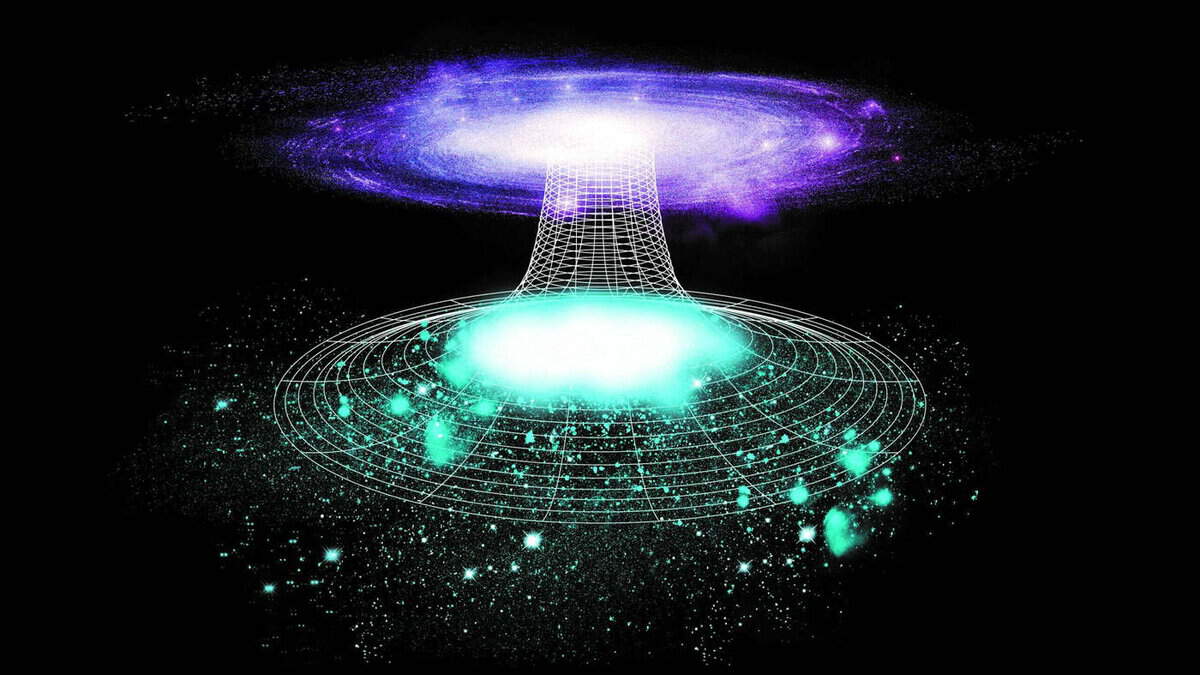While black holes cannot be directly observed, their existence is inferred through various indirect data. Conversely, white holes exist only in theory, but scientists have made observations and formulated hypotheses regarding their appearance, location, and properties. Here, we delve deeper into the topic.
Explore the concept of “Hitech”
What exactly are white holes?
A white hole is a theoretical object in the vast expanse of the Universe that prohibits anything from entering its region. It is essentially the temporal opposite of a black hole and is a product of the same equations found in the general theory of relativity. The majority of physicists firmly believe that white holes do not exist in nature.
The prevailing theory suggests that white holes could potentially form when a black hole’s substance escapes from its event horizon, moving in the opposite direction of the thermodynamic arrow of time.
Therefore, the complete fabric of space-time consists of both black holes and white holes. It is fundamentally impossible for a solitary “pure” black hole or a solitary “pure” white hole to exist within the entire tapestry of space-time.
In the 1960s, Igor Novikov, a Soviet theoretical physicist from AKC FIAN, proposed that there must exist celestial bodies with properties opposite to black holes, which he named white holes, based on the theory of relativity.
The complete Schwarzschild solution encompasses both black holes and white holes. However, it is currently believed that Schwarzschild white holes do not exist in reality. On the other hand, the full Kerr solution includes both black and white holes. Specifically, a Kerr white hole, resulting from the Kerr solution for black holes, is formed in one universe when a black hole is formed in another universe.
Emergence of the Theory of White Holes: A Historical Perspective
The theory of white holes first gained attention when astrophysicists Shlomo Heller and Alan Retter, hailing from Israel, proposed that the enigmatic gamma-ray burst known as GRB060614 could be attributed to a white hole.
This particular burst was recorded in 2006 and is known to be associated with the birth of black holes. Typically, gamma-ray bursts come in two varieties. Long bursts, lasting approximately 2 seconds, occur as a result of the collapse of massive stars into black holes. On the other hand, short bursts, lasting less than a second, are caused by the collision of neutron stars.
However, the anomalous GRB060614 event was peculiar in that it lasted for over 100 seconds without the formation of a black hole.
According to scientists, the concept of white holes allows us to envision a scenario where matter is expelled from a black hole, surpassing its event horizon. This occurrence is the antithesis of the inward gravitational pull that characterizes black holes, as it involves a forceful ejection of matter.
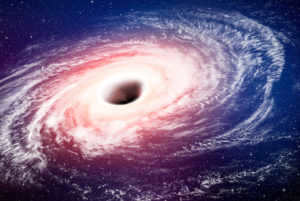
What is the appearance of a white hole?
Envision a sphere with such an immense mass that you can only escape its surface at the speed of light. This is what we call a black hole. Its gravitational radius is the term used to describe its radius. If we were to compress all of the Sun’s matter into a sphere with a radius of three kilometers, it would transform into a black hole.
The gravitational radius is also known as the event horizon. Anything that enters this sphere, such as a spaceship or a piece of celestial matter, will not be able to return. The tremendous gravitational forces will pull it into the black hole and tear it apart into elementary particles.
Atoms from the black hole fall into the white hole and immediately emerge from it, but in a different Universe. They travel from the future to the past. A white hole can be seen as a black hole that has been reversed in time.
White holes exhibit instability. As matter accumulates within them, the gravitational forces intensify and eventually cause the object to collapse, transforming it into a black hole.
It is possible that all the white holes that emerged shortly after the Big Bang are presently defunct, which explains their absence from our observations.
Where should we direct our search for white holes?
Quasars, which are the brightest celestial entities in the cosmos and the active cores of galaxies, have been proposed as potential white holes. Scientists Alon Retter and Shlomo Heller suggest that white holes spontaneously originate in space and promptly expel all matter before ceasing to exist.
They cannot be regarded as cosmic entities, but rather as “windows” in the Universe that only survive for a few minutes. It is impossible to predict the time and location of white hole formation.
According to Retter and Heller, the primary candidates for these unpredictable portals are gamma-ray bursts, which are the most powerful explosions that release high-energy particles for a duration of at least two seconds. These bursts have been detected in various regions of the Universe, located billions of light years away. If a gamma-ray burst were to occur in close proximity to Earth, it would swiftly annihilate all life on the planet.
What events can be associated with white holes?
According to Israeli astronomers Alon Retter and Shlomo Heller, the anomalous gamma-ray burst GRB 060614, which occurred in 2006, could be attributed to a white hole. Alon Retter suggests that white holes, once formed, rapidly disintegrate, resembling a process similar to the Big Bang, which Retter and his colleagues have referred to as the “Small Bang”.
GRB 060614 is a gamma-ray burst that was detected on June 14, 2006 by the Swift orbiting observatory. The unique characteristics of this burst challenged the prevailing scientific consensus at the time regarding the origins of gamma-ray bursts and black holes.
Possible sources of short bursts have been identified as the combination of two neutron stars resulting in the creation of a black hole, the merging of a neutron star and a black hole, or the merging of two black holes. Additionally, these bursts differ in their average energy (frequency) of gamma rays, with shorter bursts displaying a significantly higher energy (frequency).
GRB 060614 did not conform to the existing observational framework. The duration of the gamma-ray burst was 102 seconds, and the X-ray afterglow persisted for over a week. This event was observed in a galaxy located in the Indian constellation, approximately 1.6 billion light-years away from Earth. The temporal duration of GRB 060614 indicated that it belonged to the category of long bursts.
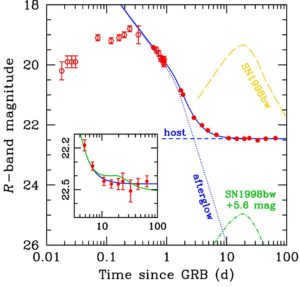
The dominant theory of a long-lasting burst had predicted that a colossal supernova would be detected through optical observations. However, none of the observatories that have observed this specific region of the sky have managed to detect either a supernova or the distinct spectral signatures of nickel-56 atoms that should be produced during the collapse of a star.
The parent galaxy of the GRB 060614 source is relatively small, weighing only about one-hundredth of the Milky Way, and contains an extremely limited number of stars that could potentially be responsible for a supernova or the origin of a long-lasting burst.
Simultaneously, GRB 060614 can be segregated into two segments based on the empirical evidence: an initial burst lasting less than 5 seconds emanating from high-energy gamma rays and a subsequent flow of nearly 100 seconds duration originating from gamma rays with lower energy. The existing data on brief bursts exhibiting a comparable radiation profile might have justified categorizing GRB 060614 within the same category, yet it possessed approximately 8 times greater intensity.
The perspective of scientists on white holes
Up until now, the detection of a white hole remains elusive, making it a mere conjecture that appears fascinating and captivating. Supporters of this hypothesis posit that their elusiveness could be attributed to their existence in regions devoid of cosmic matter, as its presence can lead to the annihilation of a white hole. The destabilization of such an entity can occur with the introduction of a single atom, resulting in a catastrophic explosion.
As of now, no concrete evidence exists for the existence of physical objects that can definitively be labeled as white holes. Furthermore, there are no established theoretical mechanisms for their formation, aside from a relic state immediately after the occurrence of the Big Bang. Additionally, no theories have been put forth regarding methods to locate them (unlike black holes, which are believed to be situated at the centers of large spiral galaxies, for instance).
Find out more
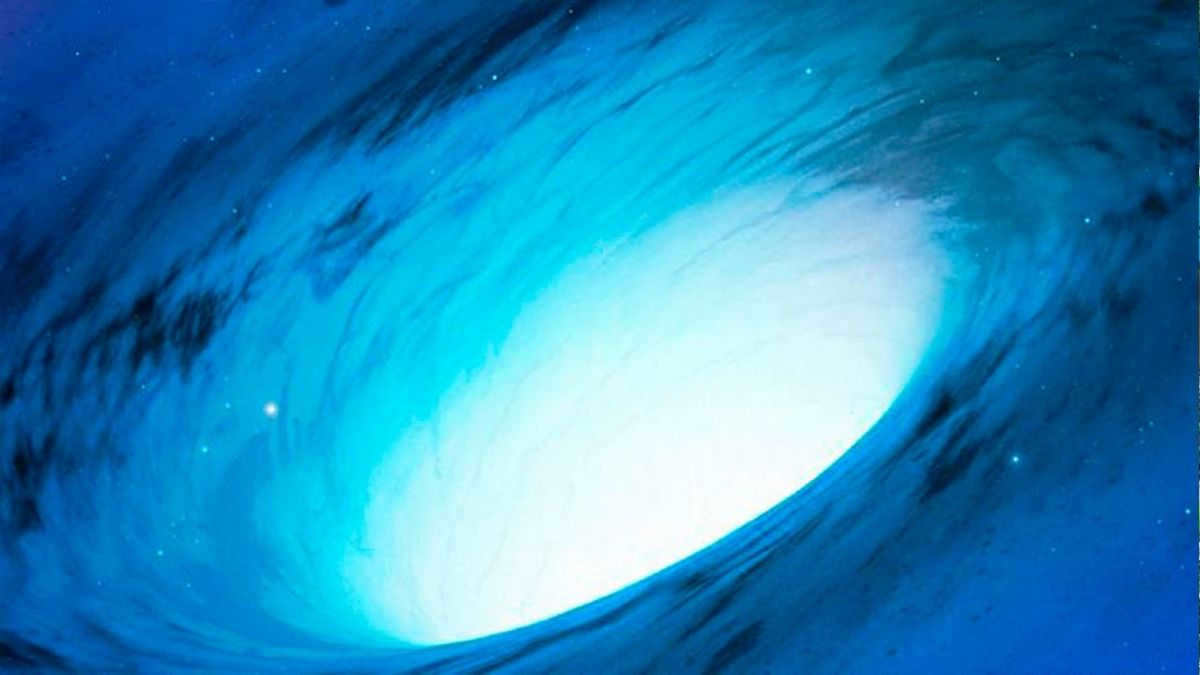
The concept of white holes was initially suggested by theoretical astrophysicist Igor Novikov in 1964.
A white hole is a hypothetical region in spacetime that is believed to be a solution to Einstein’s field equations.
However, let’s begin with black holes as they are easier to comprehend. Black holes form when the core of a massive dying star collapses inward. All of the mass is compressed into an incredibly small volume. The gravitational force becomes so intense that even light cannot escape.
White holes, on the other hand, are the complete opposite of black holes: while nothing can exit the event horizon of a black hole, nothing can enter the event horizon of a white hole. To put it simply, a white hole expels everything and nothing can enter.
The notion of a white hole is incredibly intricate. Consequently, we have endeavored to elucidate it in bite-sized portions. By the conclusion of this piece, you will possess a significantly deeper understanding of this captivating phenomenon.
Are white holes real?
A white hole is merely a theoretical mathematical concept and has yet to be observed within the cosmos. Most discussions pertaining to white holes revolve around the terms “hypothetical,” “infeasible,” and “unrealistic.”
They represent a potential resolution to the tenets of the general theory of relativity, which suggest that if eternal black holes exist, then white holes should also exist within the universe.
White holes are expected to possess certain characteristics, including mass, charge, and momentum. However, even if they were to approach the speed of light, they would never be able to reach a white hole. The reason for this is that there is simply not enough energy in our universe to pull an object into it.
Violation of the second law of thermodynamics
One of the primary reasons why white holes are deemed unrealistic is that they defy the law of thermodynamics by reducing entropy.
The second law of thermodynamics states that the total entropy of the universe is constantly increasing, resulting in a positive change in entropy. This is why white holes do not align with our current understanding of the universe.
Proof concerning the existence of white holes
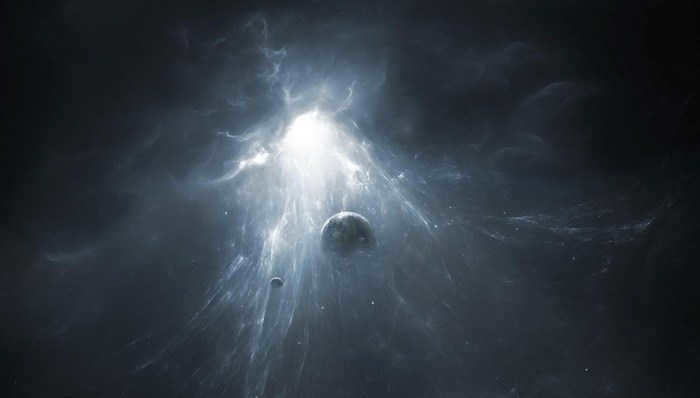
While there is still uncertainty surrounding white holes, there is evidence to suggest that the gamma-ray burst known as GRB 060614, detected by Neil Gehrel’s Swift Observatory in 2006, may be the first recorded instance of a white hole.
Unlike typical gamma-ray bursts, which only last a few seconds, the GRB 060614 hybrid burst lasted an impressive 102 seconds and was not accompanied by a supernova. This discovery challenged previous scientific beliefs about black holes and other celestial bodies that can emit gamma-ray bursts.
In 2018, scientists proposed the idea that dark matter could be composed of white holes that are incredibly small in size. These minuscule white holes would not emit any radiation and their size is smaller than the wavelength of light, making them undetectable.
Dark matter, which accounts for approximately 27% of the universe, has a local density equivalent to 1% of the Sun’s mass per cubic parsec. To explain this density using white holes, the research team estimated that one microscopic white hole, weighing about one millionth of a gram and significantly smaller than a proton, would be needed for every 10,000 cubic kilometers.
White holes could have existed before the occurrence of the Big Bang
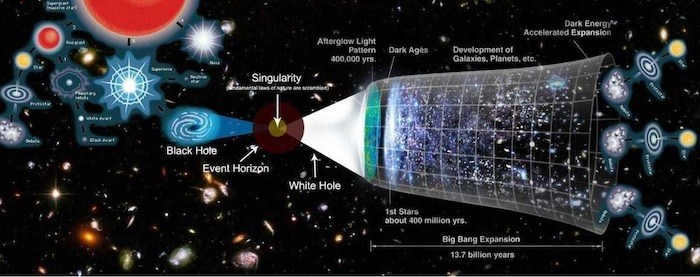
One more fascinating hypothesis proposed by scientists is that white holes might offer an explanation for the occurrence of the Big Bang, since it represents another scenario where vast quantities of matter and energy spontaneously emerged.
There have been assertions that the Big Bang resulted from the explosion of a white hole, which supposedly released all the matter and information that had been absorbed by the black hole.
Of course, we cannot ascertain the veracity of this theory, but once again, it is intriguing to consider the possibility that life originated from a white hole.
A wormhole serves as a connection between a black hole and a white hole
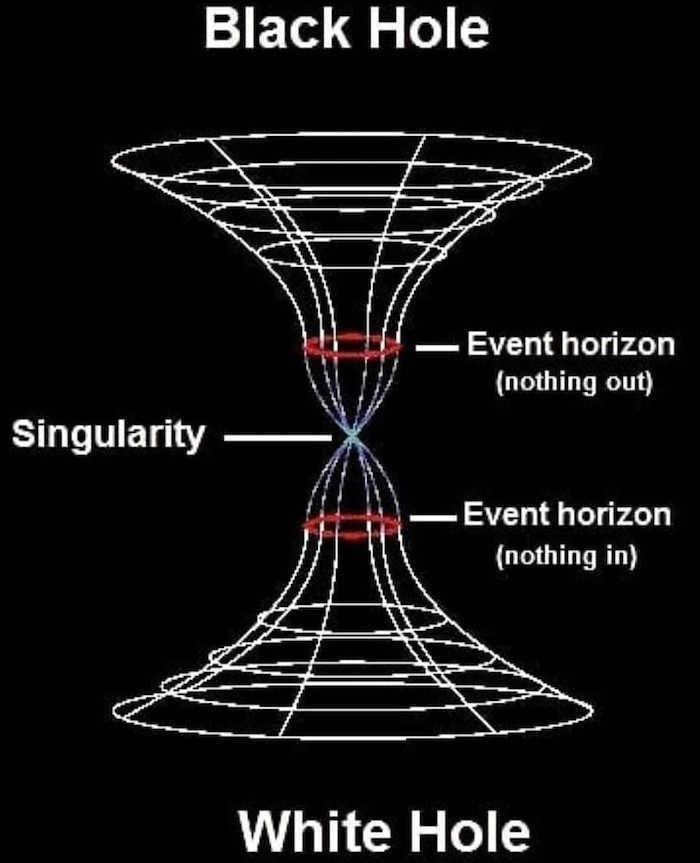
Studying the existence of white holes is important for a variety of reasons, one of which is their potential to provide an explanation for what occurs at the center of a black hole. What happens to all the information that gets pulled in?
There are several theories that propose the presence of a white hole at the opposite end of a black hole. This white hole would expel all the matter and information that was absorbed by the black hole into another universe.
The “entrance” of the black hole and the “exit” of the white hole can be linked to two entirely separate universes. This connection is made possible by a wormhole, which can be envisioned as a tunnel with two openings, each located in a different point in space-time.
The concept of wormholes is a part of the theory of general relativity, but so far, no observations of them have been made in the universe. Wormholes have the potential to connect either short distances (such as a few meters), extremely long distances (even millions of light years), or even different universes.
In 1935, scientists made a significant discovery related to wormholes. They found the first type of wormhole called a Schwarzschild wormhole, using Einstein’s general theory of relativity. The Schwarzschild metric describes a system consisting of a white hole, a black hole, and two separate worlds that are connected at their event horizons through the wormhole.
The Schwarzschild solution involves two valid equations, one with a positive square root and the other with a negative square root. The latter equation suggests that a black hole can actually travel backwards in time, essentially behaving like a white hole.
The concept of white holes opens up the potential for time travel
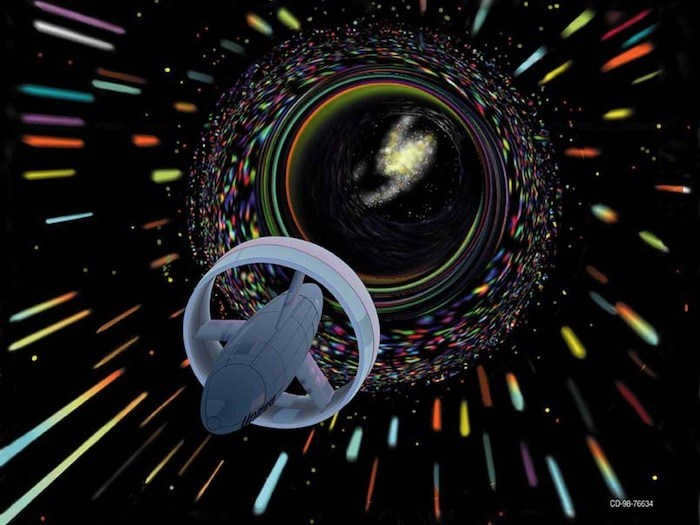
Under specific circumstances, a wormhole has the potential to connect two instances in time instead of two locations in space. As a result, an object consumed by a black hole has the potential to traverse the wormhole and be expelled by a white hole in a distinct temporal or spatial region.
Regardless, this concept possesses several drawbacks. For instance, an object descending into a black hole would be unable to withstand the immense gravitational force it exerts. Additionally, due to its extraordinary instability, the wormhole would instantaneously collapse upon itself.
Notwithstanding these limitations, certain physicists have demonstrated that a wormhole, if it were to exist, could facilitate both travel through space and time. Professor Kip Thorne of the California Institute of Technology, a Nobel Prize laureate, has proposed that these three phenomena (black holes, wormholes, and white holes) could potentially enable human beings to journey back in time, spanning thousands of years.
There are numerous theories about white holes, but scientists have yet to discover definitive proof of their existence. Perhaps there is still space for these enigmatic entities within our expansive and enigmatic cosmos.
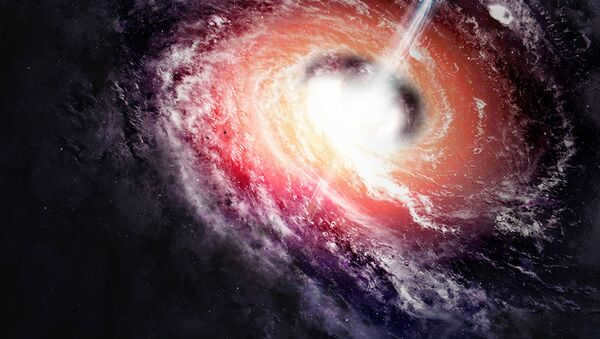
MOSCOW, October 18 – RIA Novosti, Tatiana Pichugina. Black holes are not visible to the naked eye and can only be detected through indirect evidence. On the other hand, white holes, which are the opposite of black holes, exist only in theory. It is speculated that they may have ceased to exist during the early stages of the universe or have become concealed within the vast expanse of dark matter, rendering them unobservable. This article provides an overview of what is currently known about these enigmatic entities.
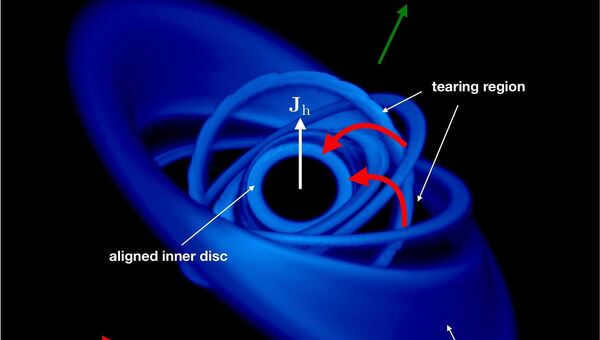
The opposite of black holes: white holes
In the 1960s, Soviet theoretical physicist Igor Novikov (AKC FIAN) proposed the existence of objects in space that are the opposite of black holes, based on the theory of relativity. He referred to these objects as white holes.
Imagine a sphere with an enormous mass, where the escape velocity from its surface is equal to the speed of light. This is what we call a black hole. Its gravitational radius, also known as the event horizon, defines its size. For instance, if all the matter in the Sun were compressed into a sphere with a radius of three kilometers, it would form a black hole.
Anything that crosses the event horizon and enters the black hole’s sphere, whether it’s a spaceship or a fragment of stellar matter, will be pulled in by immense gravitational forces and torn apart into elementary particles, never to return.
Atoms are pulled from the black hole and ejected from the white hole, but they emerge in a different universe. Furthermore, they exit the white hole from the future and enter the past. Essentially, a white hole is a black hole that operates in reverse time.
White holes, unfortunately, are not stable. As matter accumulates within them, gravitational forces increase until the object collapses and transforms into a black hole.
It is possible that all the white holes that arose immediately after the Big Bang are now defunct, which is why they remain invisible to us.
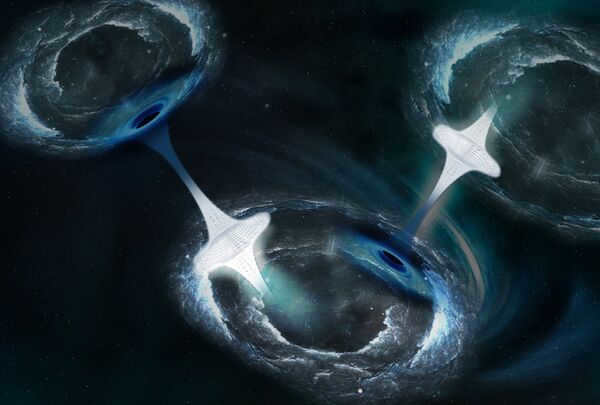
A blemish on the universe’s body
Within the realm of modern cosmology, the white hole serves a crucial purpose – without it, the creation of universes would be unattainable. In the late 1980s, Alan Guth, an American physicist and one of the creators of the inflation theory, simulated the process of a new world being born within an existing universe.
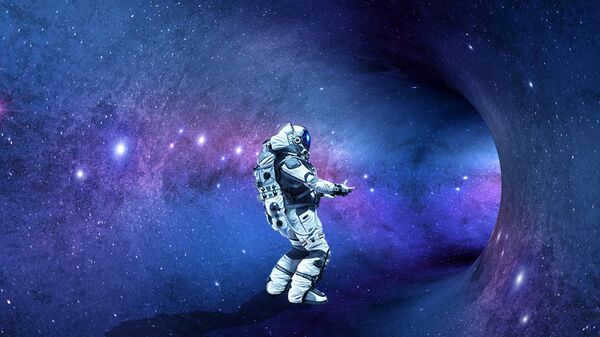
Imagine a scenario where a singularity, characterized by an extremely high density of matter and space curvature, manifests itself in the vast expanse of the cosmos. This singularity gives rise to an explosive event, triggering a rapid expansion known as inflation. The effects of this inflation are akin to a white hole, compressing space-time in the most intense manner possible.
Gradually, the white hole grows, resembling a pimple on the body, until it eventually detaches from the mother universe, leaving behind a distinctive mark in the form of a black hole. Simultaneously, the newborn universe undergoes a formation process, resulting in the emergence of what can be metaphorically described as a “belly button.” Interestingly, the “birth” scars in both universes are swiftly healed thanks to the phenomenon of Hawking radiation.
As long as the new universe remains connected to its surroundings, we have the opportunity to witness its birth and evolution within stars and galaxies. Furthermore, it is conceivable that our own universe originated through a similar mechanism within another, pre-existing universe.
Scientists have investigated the role of white holes in relation to quasars, which are the most luminous celestial objects and active centers of galaxies. In 2011, Alon Retter and Shlomo Heller, researchers from Israel, proposed that white holes are spontaneously generated in space and quickly expel all matter before vanishing. Rather than being considered cosmic entities, white holes can be viewed as “windows” in the Universe that exist for only a few minutes. The birth time and location of white holes cannot be predicted.
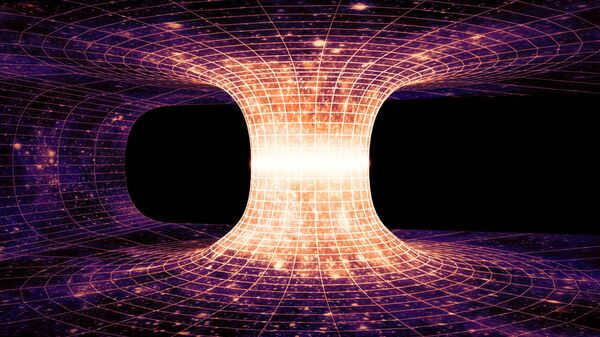
According to Retter and Heller, gamma-ray bursts are the most suitable candidates for such spontaneous “windows”. These bursts are the most powerful explosions that release high-energy particles and can last for two seconds or longer. They can be observed in various regions of the Universe, billions of light years away. If a gamma-ray burst were to occur nearby, it would quickly annihilate life on Earth.
In the month of June in the year 2006, a celestial satellite captured an extraordinary occurrence of a burst of gamma rays in the Indian constellation, situated at an incredible distance of two billion light-years away – this particular event was designated as GRB 060614. Its noteworthy features included an abnormally long duration of 102 seconds, and the absence of a supernova in close proximity that could have potentially caused it. Retter and Heller put forward the hypothesis that GRB 060614 may in fact be a white hole.
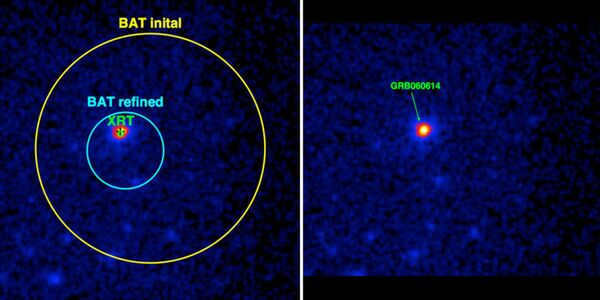
Exploring the Depths of Dark Matter
According to theoretical physicists Carlo Rovelli from France and Francesca Vidotto from Spain, a significant portion of dark matter may be comprised of white holes.
Rovelli and Vidotto have revisited astrophysicist Jane Makjibbon’s hypothesis from thirty years ago, which suggested that dark matter originated from evaporated black holes, and have concluded that these sources are actually white holes.
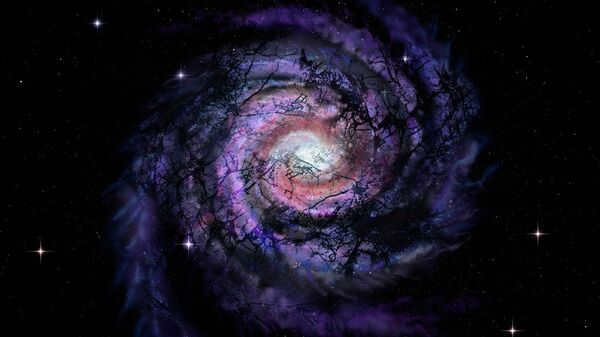
We are discussing primary black holes that were formed immediately following the occurrence of the Big Bang. Throughout the 13.7 billion years since the inception of the Universe, these black holes have gradually released matter in the form of Hawking radiation. Once they reached the Planck size (approximately 10 -35 meters), they transformed into white holes.
Different from regular-sized white holes, microscopic white holes have the potential to remain stable due to the dominance of quantum processes over gravitational processes on a microscopic scale.
Approximately a quarter of the Universe is occupied by dark matter, which is primarily concentrated within galaxies. Dark matter does not exhibit any noticeable characteristics, does not emit radiation, and only interacts with ordinary matter through gravitational forces.
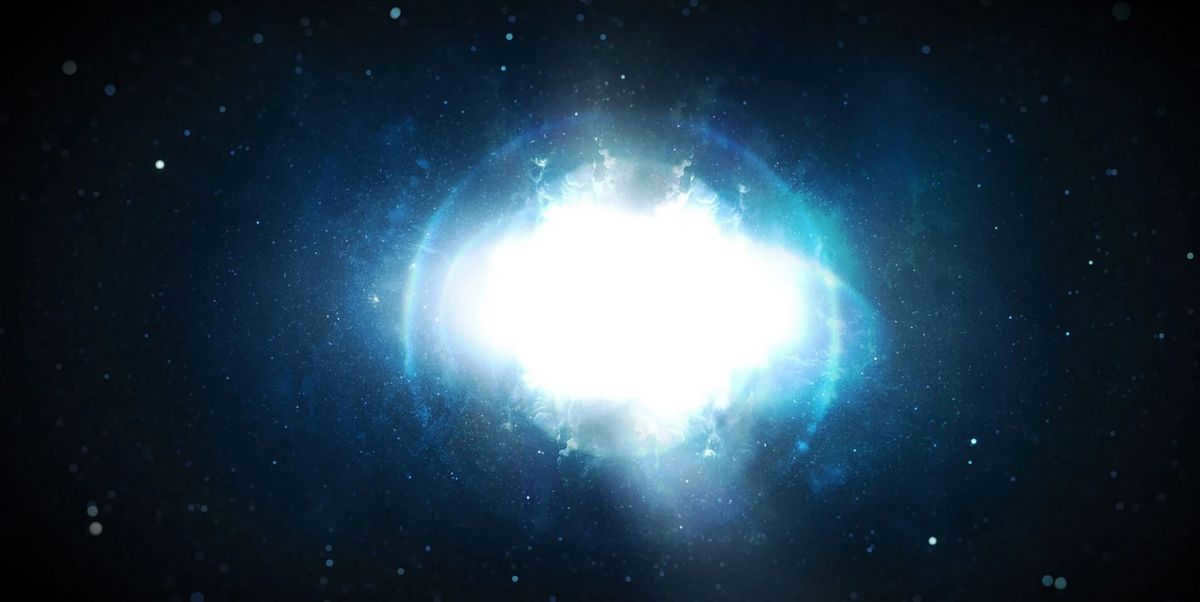
Throughout history and up to the present day, the universe has held many enigmas, including the enigmatic cosmic phenomenon known as white holes. The nature of these objects, how and why they come into existence, is a subject of contemplation.
Existence of white holes: what are these objects?
The idea of white holes in outer space originated in 1964, when the Soviet astrophysicist Igor Dmitrievich Novikov proposed the resonant hypothesis.
Novikov, a pioneer in the study of black holes as the ultimate result of stellar evolution, hypothesized the existence of a type of matter in space that would be the opposite of black holes, possessing different fundamental properties.
A hypothetical structure called a mole hole or “wormhole” is believed to connect separate points in space and time. This concept is derived from the solution of Einstein’s field equations.
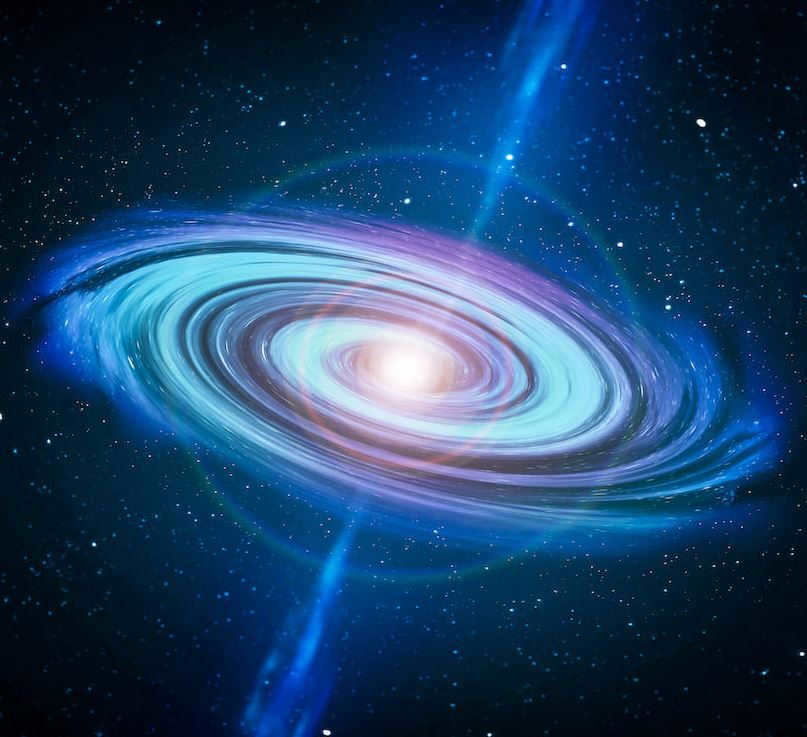
The concept of white holes was further developed by Nikolai Kardashyov, a respected scientist and astrophysicist from the Soviet Union. Kardashyov was known for his support of various theories regarding “mole holes” and dedicated his life to finding evidence of the existence of white holes. On the international stage, the study of white holes was also pursued by Stephen Hawking, the lesser-known founder of the black hole field.
Hawking proposed the idea that “black holes vaporize the mass they contain, eventually disappearing, and the information absorbed by them is then released through the rapid formation of white holes.”
According to the overall evaluation and research conducted by numerous scientists, we can highlight the current general understanding of this phenomenon. Therefore, a white hole is a theoretical entity that is believed to exist at various locations within the Universe, where entry is impossible for anything or anyone.
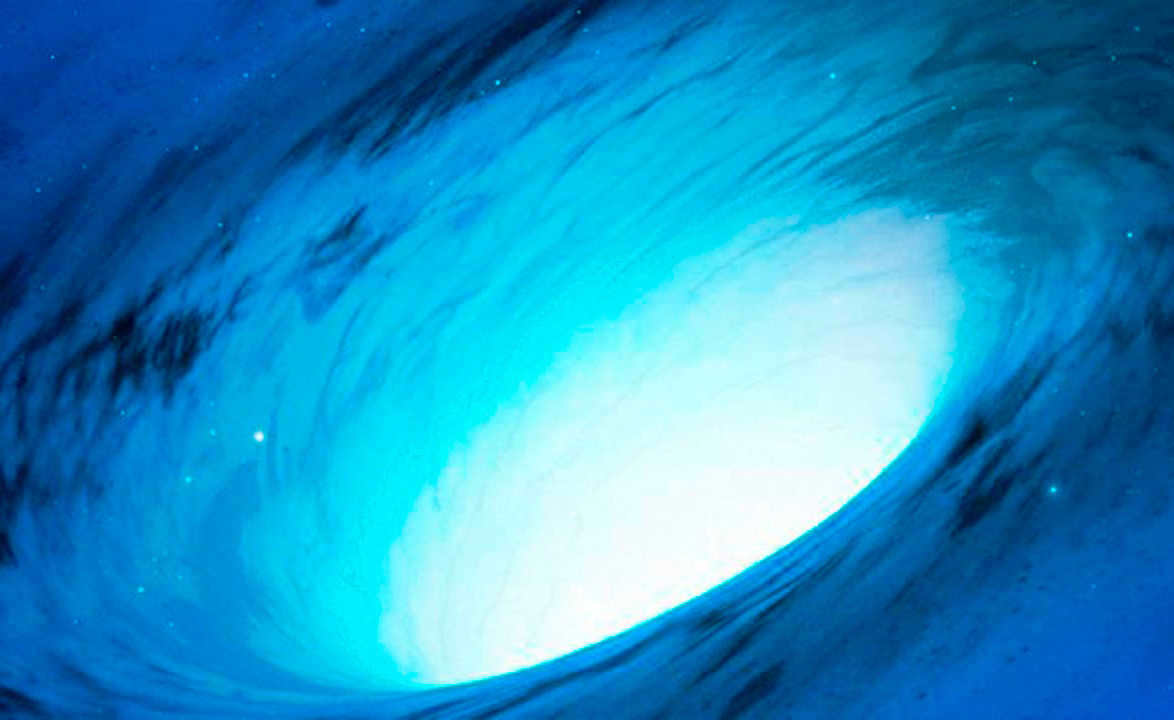
Furthermore, as per Einstein’s gravitational theory, a white hole is a hypothetical area in the fabric of space and time where entry is impossible from the exterior, yet it emits matter, energy, and light.
In present times, scientists hypothesize that white holes are the consequence of black hole evaporation – the release of vast quantities of matter that was previously accumulated and absorbed. The formation of a white hole following the evaporation of a black hole occurs quite rapidly, although to an external observer, it may appear to take millions or even billions of years.
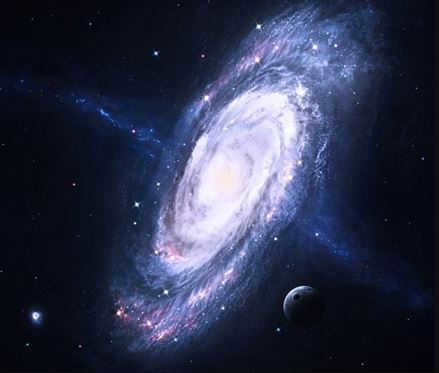
White holes are characterized by their spontaneity and instability, as they expand rapidly while their gravitational force intensifies. The first instance in which the detection of a white hole phenomenon could be examined occurred on June 14, 2006.
A peculiar gamma-ray burst, lasting an exceptionally long duration of 102 seconds, was detected by NASA’s space observatory and is believed to be the possible initial identification of a “white hole” phenomenon.
Typically, such gamma rays result in the formation of black holes, although these bursts typically last no longer than two seconds. However, due to the unusually extended “wave” observed, no black hole was formed.
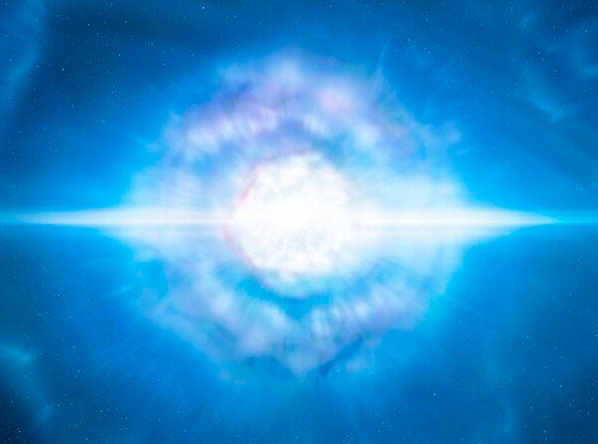
The challenge in identifying and subsequently tracking this phenomenon lies in the fact that a white hole expels its energy in a single instantaneous burst, rather than continuously like a black hole, which can be observed from the outside due to its ongoing nature.
The incident in 2006 is thought to be the initial reported instance of white matter being supposedly captured.
White and black holes
However, despite numerous predictions about the formation of dark matter through gravitational collapse, the current astronomical phenomenon being discussed is particularly intriguing.
Unlike black holes, which have an extremely strong gravitational field that prevents even light from escaping, white holes briefly appear in the emptiness of space before disappearing.
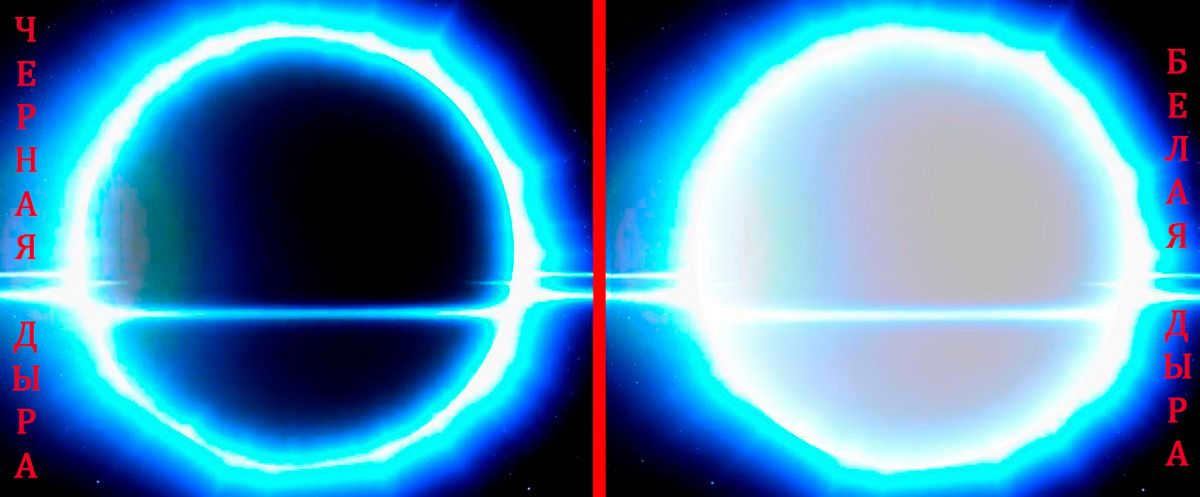
The issue of the opposition between these two types of celestial phenomena is particularly pressing: if there exists a realm where one can enter but never leave, then there must also be a domain from which one can depart but cannot enter. To put it differently, there exists a black hole, which engulfs everything that comes its way, and a white hole, conversely, which expels matter.
This is how we can account for the occurrence of the renowned Big Bang – a culmination of power and energy. It is highly possible that it resulted from the explosion of one or several white holes, propelling the enormous accumulation of matter that was once absorbed by the black hole, on an unimaginable scale.
Characteristics
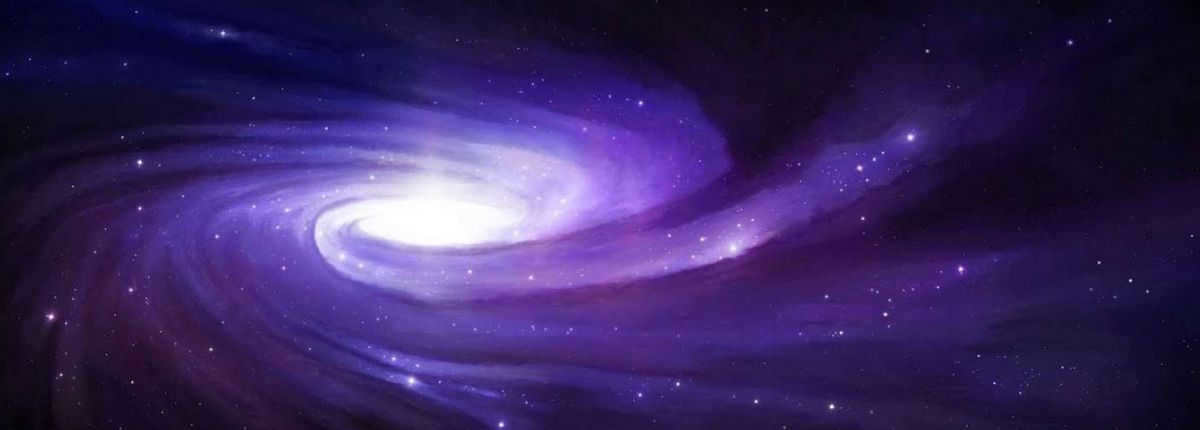
The exploration of white holes is connected to a range of related aspects. Currently, regrettably, no known physical process exists that could result in the formation of a white hole. Furthermore, some researchers question the very existence of this phenomenon as it appears to contradict the second law of dynamics.
However, the interpretation of entropy, which is mentioned in this law, varies, making it impossible to definitively determine the possibility or impossibility of the aforementioned phenomenon.
Entropy is a scientific concept and a measurable physical property that represents the extent of irretrievable dissipation of energy.
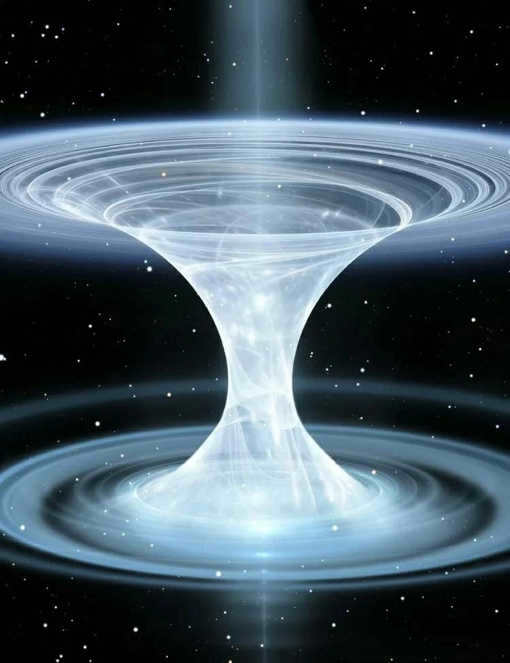
A notable characteristic of this celestial phenomenon is that even though objects or information within it have the capability to exit and thus interact with the external world, there is no means by which we can penetrate it and consequently impact its internal workings.
It is quite peculiar, then, to fathom that something supposedly situated in white holes could one day depart from the confines of its existence and exert influence on the Universe, alter the course of events, and perchance even shape history.
The brief duration of each individual white hole can also be regarded as one of its distinctive traits. This is likely due to the fact that any departing matter would collide with the matter in orbit and collapse into a black hole.
People often wonder
Similar to black holes, white holes possess physical characteristics such as angular momentum, charge, and mass.
Their instability is governed by gravitational phenomena. However, not all white holes exhibit this trait. It is postulated that microscopic holes have the potential for stability, as quantum processes become prominent at the micro level.
It is hypothesized that there may be an equal number of white holes as there are black holes, as their merger creates a tunnel where they exist on opposite sides. This symbiotic relationship allows the black hole to absorb matter and the white hole to expel it into space, albeit in a different time due to distortion.
The first reported instance of a suspected white hole occurred in 2006 in the Indian constellation, located 1.6 million light-years away.
A wealth of information on white holes can be found on English-language space forums, like Universe Today. Furthermore, these inquiries can be discussed at international scientific and practical conferences, and references, hypotheses, and physical laws supporting the existence of white holes are embedded within the principles of contemporary natural science, essays on the history of astronomy and astrophysics, as well as in the writings of physicists Carlo Rovelli and Francesca Vidotto.
It was Rovelli who first introduced the phrase:
“White holes are black holes in reverse”.
Conclusion
Therefore, the formation of white holes is still an uncertain area of study, and their existence remains unconfirmed. Nevertheless, the current discoveries and scientific research in this field represent significant progress towards understanding this extraordinary cosmic event.
Some suggest that a white hole is the result of a black hole’s demise, but only time will tell if this hypothesis holds true. Perhaps, it will be our future generations, if not us, who will eventually unravel this cosmic enigma and witness the enigmatic phenomenon of a white hole firsthand.
Bravkov, K. P. The Existence of White Holes: Theories on Their Existence / K. P. Bravkov. – Text: original // Young scientist. – 2022. – No. 38 (433). – pp. 69-73. – URL: https://moluch.ru/archive/433/94998/ (accessed: August 18, 2023).
Every individual has encountered the concept of a “black hole” at least once in their lifetime. In science fiction movies, books, and TV shows, the portrayal of a black hole has been depicted as one of the most terrifying and enigmatic phenomena in our vast Universe.
Picture a massive sphere so incredibly dense that you can only escape its surface at the speed of light. This is what we know as a black hole. If we were to compact all the matter of the Sun into a sphere with a radius of three kilometers, it would transform into a black hole. I’ve always been fascinated by the theory and nature of black holes, and I’ve read extensively on the topic. However, I was completely unaware of the existence of white holes. As it turns out, there is a white counterpart to a black hole.
In the 1960s, Soviet theoretical physicist Igor Novikov (AKC FIAN) deduced, based on the principles of relativity, that there must be objects in space with properties opposite to those of black holes. He referred to these objects as white holes.
Indeed, in addition to black holes, there has been much discussion about white holes. The concept of white holes suggests that they are regions that, unlike their black counterparts, repel everything and allow nothing to enter. They are like tightly sealed objects. This fact intrigued me, and I delved into it further.
A white hole is a hypothetical object in the Universe where nothing can enter. It is the temporal opposite of a black hole and is predicted by the same equations of the general theory of relativity. While most physicists believe that white holes cannot exist in nature and only exist in theory as the opposite of black holes, there have been observations and speculations about their appearance, location, and properties.
A variety of inquiries arose in my mind: what are the voids in the cosmos, what sets apart the characteristics of Black and White holes, what is the fundamental concept behind the theory of hole creation, and what do we know about this theory based on historical records?
Supposition: White holes. Reality. Fiction.
Objective: To discern the factors that validate the veracity of the theory of White Hole existence, as well as the factors that disprove it.
1. To delve into the chronicles of various theories on the origin of Black and White Holes in the universe.
3. Are there any arguments supporting the theory of White Hole formation?
In order to delve into the topic of White Holes, we must first acquaint ourselves with their counterparts, specifically Black Holes.
Hawking radiation
After acquainting ourselves with Black Holes and forming a rough understanding of their structure based on existing information, we can delve into the topic of their counterparts, White Holes.
What exactly is a White Hole? A White Hole is a theoretical physical entity in the Universe where nothing can enter. It is essentially the opposite of a Black Hole and follows the same principles outlined in the general theory of relativity. While most scientists believe that White Holes do not exist in nature, this assumption is yet to be proven.
Several hypotheses have been proposed by numerous scientists to explain the nature of a White Hole. One prevalent theory states that a White Hole is an imaginary entity that emerges following the demise of a black hole. Alternative explanations exist regarding the genesis of White Holes. One such proposition suggests that White Holes are formed during the birth of a Black Hole, implying that White and Black Holes function as gateways to alternate universes. The variety of theories surrounding White Holes is extensive and exhaustive, but let us focus on the most credible ones.
The initial theory is based on the concepts put forth by Stephen Hawking. In the 1970s, S. Hawking proposed that all black holes undergo a process of mass evaporation through the emission of radiation. This implies that black holes which lose more mass than they gain will shrink and eventually cease to exist, in other words, they evaporate. To identify a black hole in the process of evaporation, a set of equations developed by Hawking must be employed. Let us delve into the methods of locating a potential black hole according to Stephen Hawking’s research.
Black hole evaporation is a phenomenon rooted in quantum mechanics. It can be explained as follows: according to quantum field theory, the physical vacuum is filled with particles. When subjected to external influences, the behavior of these particles changes, and under certain conditions, particle-antiparticle pairs can be spontaneously created from the vacuum. Such processes occur within the event horizon of a black hole. Consequently, it is possible for one of these particles to fall into the black hole while the other escapes. Following the principle of energy conservation, the particle that falls into the event horizon will possess negative energy, while the particle that remains visible will possess positive energy. As a result, when these particles “extract” energy from the black hole, it begins to lose mass and gradually diminishes. To locate a black hole undergoing this process, a series of calculations must be performed.
The tidal effect would cause a difference in the forces experienced by the electron and positron.
Here, Lc represents the wavelength and L represents the scale of the gravitational field.
The formation of pairs is governed by the principle of energy conservation, meaning that the work done by tidal forces must be equal to the energy required to create the pairs:
However, when considering a non-rotating mass that is spherical in shape, denoted by M, and located at a significant distance r, the acceleration and birth condition of the particle will be as described below:

the gravitational radius will be RG=
The energy required for one particle of the pair to escape from the black hole is derived from the absorption of the other particle by the black hole. In the gravitational field, the electron-positron pair gains energy at a specific distance, denoted as E~.

The responsibility for this energy falls on
Thus, the birth of electron-positron pairs will occur at this point.
It is crucial that the radiation is accompanied by a thermal spectrum, which can be determined using the following formula:

Once we have addressed the phenomenon of Black Hole evaporation (Hawking Radiation), we can proceed to discuss one specific hypothesis.
Hypothesis: By conducting a series of calculations based on Hawking’s theory, we can identify a Black Hole that will gradually dissipate over time. As it vanishes, a transient White Hole will emerge in its place, accompanied by an emission of energy. This occurrence is made possible by the acquisition of identical charges by two opposing particles.
Explanation: Imagine that inside a Black Hole, two electrons are formed, one with a positive charge and one with a negative charge. When one of the electrons acquires the same charge as the other one, the energy will escape the Black Hole at a high speed. This moment is known as the energy ejection, and it transforms the Black Hole into a White Hole.
Let’s illustrate this concept with an example. If you bring the opposite poles of two magnets close to each other, the charges inside them cause the magnets to attract. However, if you bring the same poles of two magnets close to each other, they will repel each other due to the identical charges. Similarly, in the context of PD, when homonymous particles are formed and one of them accumulates energy, PD will cease to exist, and the energy will rapidly leave due to the influence of the identical charges.
The occurrence of gamma-ray bursts as a result of white holes
Before we delve into another theory regarding White Holes, it is essential to grasp the concept of gamma-ray flares. Gamma-ray bursts (GR) are massive bursts of explosive energy that occur in distant galaxies. These bursts can last anywhere from milliseconds to an hour. Typically, the initial burst is followed by a prolonged “afterglow”. Gamma-ray bursts are formed when the rapidly rotating core of a massive star collapses, resulting in the creation of a neutron star or a Black Hole. Another possible formation of a gamma-ray flare is through the merger of two neutron stars. The sources of gamma-ray flares are located billions of light years away from Earth. In just a matter of seconds, a flare releases an amount of energy equivalent to that of the Sun over a span of 10 billion years. The first gamma-ray flare was accidentally detected on July 2, 1967, by the Vela satellites of the U.S. military. Numerous theories have been proposed to explain the mechanisms behind gamma-ray flares, but it was not until the recording of X-ray and optical afterglows in 1997, along with the measurement of their redshift using an optical spectroscope, that there was sufficient data to support these theories. These discoveries, along with subsequent studies of galaxies and supernovae associated with gamma-ray bursts, have helped scientists estimate the brightness and distances to the sources of these flares, ultimately localizing them in distant galaxies and connecting them to the demise of massive stars. However, the investigation of gamma-ray bursts is an ongoing process, and they continue to remain one of the mysteries of astrophysics. Gamma-ray flares are recorded approximately once a day.
Now, let’s proceed to the subsequent hypothesis. Hypothesis: Suppose that White holes are responsible for Gamma-ray flares. By evaluating Gamma-ray flares based on specific criteria, we can predict the location of the forthcoming manifestation of the White Hole.
Clarification: Assuming that a Black Hole undergoes various stages including 2 phases and 2 interphases, it can temporarily transform into a White Hole during the interphase, resulting in the generation of Gamma Flashes. These interphases involve a transition from a Black Hole to a White Hole, during which an immense amount of energy is released. In phase I or III, the Black Hole accumulates energy due to its significant gravitational force. However, when the phase changes to phase II or IV interphase, the stored energy in the Black Hole is forcefully expelled, causing it to become a White Hole. To identify such a Black Hole, we will compare its spatial location, galaxy, year, and time. By conducting calculations, we can predict when the next outburst will occur.
If we accept the calculations, the suspected source of Gamma-ray flares known as 170101A, can be attributed to a White Hole. The coordinates for this event are 17h 48m 25s +11°39’.
Interestingly, there are several other Gamma-ray flares that share the same coordinates.
However, an alternative theory stems from this initial one. Hypothesis: When our universe expands or contracts, there may be slight errors in the coordinates. By following the same methodology as the previous theory, we may discover additional White Holes.
White hole radiation.
Hypothesis: White holes, much like Black holes, emit radiation that follows the principles of Hawking radiation. However, the phase period and interphase must be taken into account, as there is an accumulation of energy during the moment of phase change.
Explanation: Accumulation of energy occurs when PD is in phases I and III, and this energy is released during interphase periods. Based on this, it can be inferred that the radiation of white holes follows Hawking radiation, but with consideration of all factors. Consequently, the formula for the thermal spectrum of black holes will undergo a change in form from

The n-period of phase and interphase, ħ is the reduced constant of Planck, c is the velocity of light in vacuum, k is the constant of Boltzmann, G is the constant gravitational, M⊙ is the mass of the Sun and finally M is the mass of the black hole.
Space energy – A form of alternative energy that utilizes the Sun’s energy to produce electricity, utilizing a power station located in Earth’s orbit or on the Moon.
However, White Holes, also known as Gamma-ray flares, have the ability to emit energy that is equivalent to the Sun’s resting energy. This energy is released within a brief timeframe.
Theory: By deploying satellites to capture the energy of White Holes rather than relying on the energy of the Sun, we can obtain an alternative source of energy relatively quickly.
Explanation: The energy of White Holes can be captured by satellites, which can then transmit it to Earth using radio waves and large antennas. Another option for energy transmission is through the use of lasers to transmit a beam of light, which can be received on Earth by a light catcher. There are also other methods of energy transfer, such as the use of photovoltaic cells, which convert the energy of photons into electricity. However, the efficiency of this method ranges from 16% to 43%.
Disadvantages: One major drawback is the high cost. The expenses involved in launching a system with a total mass of 6 million tons into orbit would only be recovered after 40 years.
One issue associated with the development of such an alternative energy system is the significant energy loss that occurs during transmission. Approximately 35-50% of the energy will be dissipated when it is transferred to the Earth’s surface.
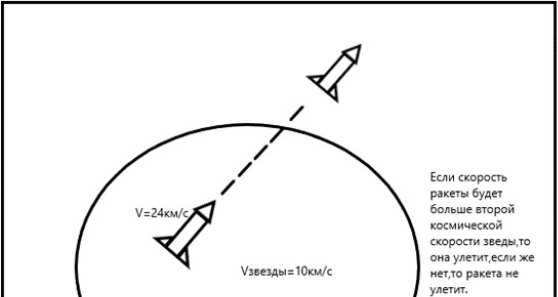

Figure 3. The transformation of phases and interphases. The I and III phases represent the Black Hole, while the II and IV interphases correspond to the White Hole.
2. Weinberg, S. “The Major Challenges of the Big Bang,” Istoki Magazine, No. 1, 1999. – 20 p.
3. Vorontsov-Vel’yaminov B. A. “Galaxies, Nebulae, and Explosions in the Universe,” “Znanie,” 2007. – 176 p.
4. Stephen Hawking and Leonard Mlodinow. – The Briefest History of Time. Publisher: AST, 2019-160 p.
5. Stephen Hawking. – Black Holes. BBC Lectures. Publisher: AST, 2020-64 p.
6. Stephen Hawking. – Black Holes and Young Universes. Publisher: AST, 2017-174 p.
7. Stephen Hawking. – On the Shoulders of Giants. Publisher: AST, 2019-256 p.
Related Articles
Astrophysical enigmas of black and white holes Journal article.
The expression “black hole” was coined by researcher J. Wheeler in 1967.
This celestial speed is dependent on the mass and radius of the celestial body.
These velocities can be explained if Sagittarius A is a black hole with a mass of 2.6 million solar masses.
This is the region where the second celestial speed surpasses the speed of light.
Article in the journal Young Scientist about Black holes
This region is where the velocity of cosmic objects exceeds the speed of light.
Black holes are incredibly massive, resulting in their cosmic velocity being faster than the speed of light.
These immense black holes consume a significant amount of energy due to the heightened disruption in space. A charged rotating black hole functions as an accelerator for particles.
Existence of dark voids Article in the publication “The Young Scientist”
The article explores the nature of such celestial entities like black holesand their
where G represents the gravitational constant ( ; M represents the mass of the entity, kg; c represents the velocity of light, m/s.
The largest documented black holes currently available are listed in Table 1. Table 1.
Shapiro S. A.,Tewkolski S. A. Black holes, white dwarfs and neutron stars: in 2 parts. Ch. 2. Translated from English.
Black Holes: Puzzles and Clues Journal Article
– Stellar-mass black holes formed from the demise of massive stars
Black holes are so incredibly massive that their cosmic velocity surpasses the speed of light.
Astrophysical enigmas surrounding black and white holes Journal Article.
This is the region where the cosmic velocity exceeds the speed of light.
The theory regarding the nature of black holes Journal article.
Kostylev, I. G. Theory about the essence of black holes / I. G. Kostylev, G. E. Esman.
where G represents the gravitational constant, which is equal to; M symbolizes the mass of the celestial body; c stands for the velocity of the black hole. speed of light in vacuum, equal to 299 792 458 m/s.
– In the event that the actual size of a black hole is smaller than the event horizon, then the second cosmic velocity у
Astrophysical enigmas of black and white holes Magazine article.
Neutron stars or “black holes” are celestial objects where the matter density is incredibly high, preventing the existence of any particles. Particles.
In the case of a star, light has to pass through not just a homogeneous medium, but also gases.
The amount of energy released in this scenario is greater than what our sun emits in 10 years. Of energy
White dwarfs, neutron stars, or “black holes” are examples of such high-energy objects.
Development of cosmological models based on multiples.
Currently, it is widely accepted that the superstring theories are one of the leading frameworks for understanding the fundamental nature of the universe.
5. It is reasonable to anticipate that the particles’ mass and quanta, as well as their spin and electric charge, are determined by these theories.
According to the theory of relativity, the masses of matter are associated with energy (although this energy is not localized).
Considering the curvature of spacetime is essential for developing a consistent theory of black holes.
Extraordinary particles in the world of scientific research
2.2.4. Symmetries and the phenomenon of spontaneous symmetry breaking among elementary particles.
By utilizing symmetries, we are able to classify and restrict the development of theories pertaining to particles.
These theories are limited to extremely high levels of energy, where particle acceleration approaches speeds close to that of light. As we know, the energy is directly proportional to velocity, and this energy is used to target specific objectives.

